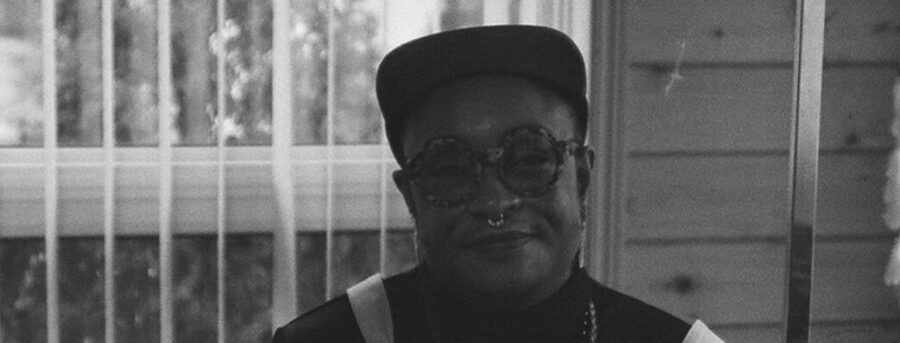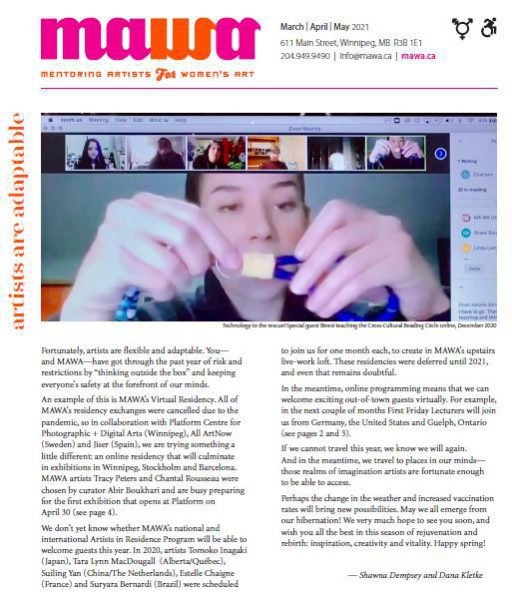
Art and Accessibility Amidst a Pandemic
by melannie monoceros
Amongst the art worlds across Turtle Island, much of 2020 found artists and organizers experimenting, fumbling, trying new things, and offering alternative invitations and exhibitions.
While I am, as a Black, disabled artist, used to surviving and creating within, alongside, and underneath capitalism, oppression, racism and ableism, the pandemic revealed a new level of perceived disposability. Something became unearthed in a more aggressive way as the pandemic spread and regulations intensified. Much of the messaging in the early weeks discussed how the only people really affected would be elders and the immunocompromised, while everyone else might get it and be okay. We essentially had government heads telling the public that the risk wasn’t so high because the only people we would be losing are sick or old.
We witnessed crowds marching against public health regulations; we witnessed governments promoting inter-country or inter-provincial travel over preventative healthcare; we witnessed numerous instances of our friends, co-workers, exes, teachers, neighbours choosing versions of self-care that put themselves and others at risk. It was painful watching friends, family members, community, kin become ill or pass away without the deserved care and comfort surrounding them (because of the restrictions), while other groups of friends went to the cottage, or had “small” semi-masked, sort-of-distanced gatherings.
It was this interesting paradox of observation.
My life, for example, is made up of a lot of staying home alone, conducting work virtually, building long-distance kinships, ordering essential items—pre-, during and post-pandemic, this is some of my truth.
The prospect of a similarly shaped daily life, for most normals anyway, was so abhorrent that we couldn’t even keep our initial lockdown measures for the three months it takes to build a new habit. (As should be understood, I am not talking about essential workers like healthcare workers, cab and transit drivers, postal workers, grocery store clerks, pharmacists, etc.)
One of the most challenging things to arise was witnessing the world doubling down on its disregard for disabled, chronically ill, neurodivergent, and Deaf people. The level of gaslighting of disabled people’s voices and stories that occurred early on during the pandemic and subsequent quarantines, while not surprising, was, quite emphatically, heartbreaking. On one end, the rhetoric was very much centred around our lives being disposable if that meant more ease, comfort, and less social disruption to the rest of society. On the other end, *poof*—everything was magically available digitally and remotely. As long as you had a computer, a fast Internet connection, a camera, and could hear or read lips. (The majority of events that shifted online did so without basic accessibility measures, such as captions or ASL interpretation). By April 2020, the majority of those who could work from home were opting or mandated to do so. Internet companies extended usage overages, clothing companies began marketing “professional loungewear,” three times as many people were using grocery and other delivery services to get their needs met, without shame.
If over the first year of this pandemic you came across the terms “mutual aid,” “care collective,” “community fridge” and others, you have sick, disabled, LGBTQIA+2s people and BIPOC (Black, Indigenous, and People of Colour) to thank. Along with the wisdom and widespread support those terms engendered.
Suddenly, after years of going through a myriad of gatekeeping hoops in order to engage with the world more accessibly only to be told, “No; not possible; you’re not right for the position; it would wreck the vibe of the event; it’s just really important that we are all in the same room for this, you understand;” after losing opportunities, income, professional, social, spiritual, and cultural connections; after being told we are replaceable because we cannot participate in person—turns out it is actually super-possible, even easy for some. The request just has to come from the neurotypical, able-bodied, “economic producers” of society.
We (disabled, chronically ill, Deaf, Mad people) felt it coming. We knew what this could mean for us and our kin. We showed up for each other. We showed up for ourselves when that was the only option. We practised radical vulnerability in order to build intimacies across distance and to cushion ourselves with what care we could.
We (metaphorically) looked at each other with narrowed gazes when scores of able-bodied folk both took our viral vulnerability for granted by continuing to go out, host gatherings, travel unnecessarily, etc. and wailed about how lifestyles like this—at home, unable to see who or go where you want, shaping the majority of your decisions around the potential risk to your immune system—were completely unacceptable and unsurvivable. Living every day with the above considerations is not unfamiliar to many disabled people. I know it is very familiar to me.
As we collectively breathe out the dust of 2020, which we will be doing for seasons to come I imagine, I am left with a vibrating inquiry.
In the coming years, as the first cohorts of COVID long-haulers (those with lingering or lifelong symptoms, etc.) begin becoming more normalized enrichments to our communities and societies, the percentage of people living with disability, chronic illness, neurodivergence and struggling with their mental health will increase greatly.
How are you going to show care and welcoming to all the non-normative ways of being a body in our increasingly distanced and virtual world?
No, really, I’m asking.
For me, the purpose of accessibility is to invite and allow all present to be in the space, virtually or otherwise, as their whole and fullest selves; to be able to experience the event or meeting/gathering with as few barriers as possible. Removing barriers to participation also gives agency to your participants to gauge their capacity and level of engagement. Reminder: this continues to be an impossible time for our collective mental health and our abilities to rest and grieve.
I offer here a list of possible options. The below applies to calls for submission; exhibitions; panel discussions; theatre performances; film festivals and screenings; poetry readings and book launches; zoom meetings and other online gatherings.
Twelve Accessible Things to Consider When Art-Sharing/Hosting:
1. Consider access first, not as an afterthought. This includes your yearly budgets and grant proposals. We’re tired of being told that you don’t have the money. We’re tired of being told that the presence and comfort of able-bodied people is more important than ours, which is the message conveyed when accessibility and accommodations are ignored.
2. Include an agenda! There is enough uncertainty in the world, tell your guests what they can expect and always give them an out if it doesn’t work for them. It can be brief and have items still to be determined.
3. Caption ALL films, video, and live performances. Filmmakers: I promise you, it will not degrade the integrity of your work. Practice composing your scenes or frames with captions/subtitles in mind. If you’re filming in a language paired with subtitles, keep in mind the placement of them and if they will be obscured by the captions or vice-versa.
4. Image and material descriptions Especially on social media! Include a description in the caption because not everyone’s device works with the alt-text feature. Descriptions are necessary for Blind and low-vision folks using screen readers online to have the image relayed to them, as screen readers cannot pick up images. Descriptions are also useful for neurodivergent people and others who are cognitively diverse to help understand the image and its context. They can additionally provide the describer an opportunity to highlight the elements they might want to draw attention to such as lighting or composition.)
5. ASL interpretation If there will be speaking or singing there should be interpretation or captioning.
6. Audio-describe live events and films/videos when possible. Describe any actions, settings, special effects or other visual business that make up the scene.
7. Request that everyone put their pronouns beside their name in the meeting. Not all women are “shes” and “hers”. Not all men are “hes” and “hims” Not all gender nonconforming people are non-binary or use “they/them”. If your event is specifically for women, or femmes or nonbinary people recognize that those labels are not interchangeable.
8. Make everything that can be recorded and archived available afterwards with transcriptions (even if it is for a set or limited time, the option to attend something at our own pace is crucial). Just because it is online doesn’t make it automatically easier for someone to attend.
9. Content warnings include flashing lights, loud or disruptive audio, as well as the more familiar warnings for violence, nudity, harsh or problematic language, etc.
10. Offer touch tours when possible (invitation for Blind and low-vision visitors to get a tactile sense of what is presented on stage or in a gallery); offer video tours for in-person work.
11. Display accessibility information for the event: venue (virtual & in-person), log-in and tech requirements, transit/parking, scent restrictions, washrooms, etc. clearly on your website. This includes any measures taken to align with Covid-19 precautions and protocols.
12. Never assume a solely able-bodied audience.
melannie monoceros is a poet and interdisciplinary artist exploring polysensory production and somatic grief through text/ile and film. Their work considers a collective qrip (queer+crip) consciousness by connecting to marvellous bodies living with complexity as sick or disabled. A Black creator of Taino/Arawak (Xaymacan) heritage, they live in Treaty 1/Winnipeg, MB with their dog Onion.

